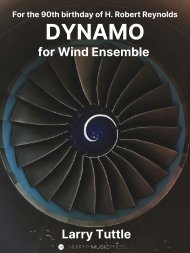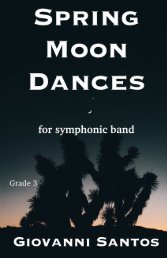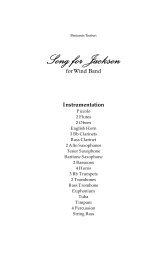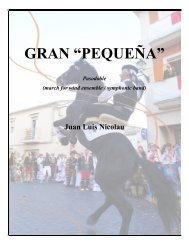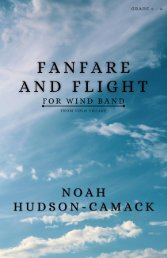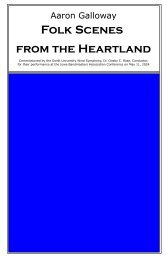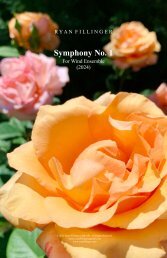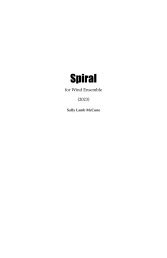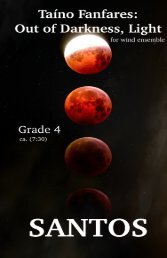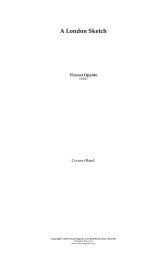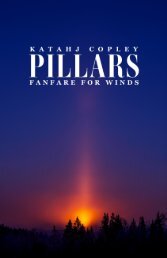Create successful ePaper yourself
Turn your PDF publications into a flip-book with our unique Google optimized e-Paper software.
!<br />
PERFORMANCE NOTES:<br />
!All accidentals carry through the measure and apply only to the octave in which they appear. In highly chromatic<br />
passages, courtesy accidentals have been provided. All key signatures have been excluded, including parts for<br />
transposing instruments.<br />
!<br />
Unless otherwise indicated, ∞ = ∞ at all meter changes.<br />
!<br />
Boxed note figures (as seen in movement III) indicate that players repeat the enclosed figure, at the given<br />
dynamic level, and sustain this texture for the full duration of the attached arrow.<br />
!<br />
Whistle tones (sometimes called whisper tones) are called for in movement 3 of the flute parts. They are very soft<br />
harmonics played above the notated fundamental. Resulting harmonics are indeterminate, but project best in<br />
the third register.<br />
!<br />
Percussion 3 and 4 play amplified steel string acoustic guitars during movement 3. Guitar experience is not<br />
required for these parts; it includes strumming open-tuned chords on open strings and harmonics (which may<br />
require some practice). Guitars with built-in pick-ups are highly recommended. Amplification levels should be<br />
set conservatively, so that the overall volume is slightly louder than a grand piano a mezzo-piano. Amplifiers<br />
should be placed antiphonally, in the back of the ensemble.<br />
!<br />
!<br />
PROGRAM NOTES:<br />
!<br />
Beacons began as a re-working and expansion of a piece composed in 2011 for Dinosaur Annex Music<br />
Ensemble (a contemporary chamber ensemble based in Boston), premiered as a side-by-side performance<br />
between professional players and advanced high school students. In its original chamber form, I was interested<br />
in using imitation to gradually shift the “who is following who” from the students imitating the professionals early<br />
in the piece, to the professionals imitating the students later in the piece. This decision to empower the younger<br />
players was very much rooted in my own creative development at the time: I was reconnecting with much of the<br />
wind ensemble music that inspired me to take up composition as a teenager and trying to connect it with what I<br />
felt was becoming my own idiosyncratic compositional voice. After the premiere in 2011, I had hoped I might<br />
some day be able to use the material in a piece for wind ensemble, and thus sat an unfinished re-arranging of<br />
the piece on my desk for five years. When Dr. Cynthia Johnston Turner asked for a <strong>new</strong> work, I decided it would<br />
be a perfect opportunity to expand the piece and connect it to the medium that inspired much of it. The first<br />
three movements, Daybeacon, Relays, and Orbital Lights, were each reimagined to take advantage of the range<br />
of sound offered by a the larger ensemble. I composed Polaris to be an extra movement, not in the original<br />
version, at the recommendation of several friends and mentors who said the piece was in dire need of a finale.<br />
!<br />
While the piece is not narratively programmatic, each movement was inspired by images I associate with<br />
different types of beacons. Daybeacon imagines choppy waters, as we hear the main theme submerged and<br />
shifting. Relays is associated with relay beacons, passing rhythms and phrase fragments in paths around the<br />
ensemble. Orbital Lights is inspired by an imaginary lighthouse scenario: a beam of light, slowly revolving chord<br />
progression (lead by the piano, harp, and guitars), one-by-one illuminate faint, shimmering textures underneath<br />
a placid surface. These textures become more or less clear upon each rotation, but softly disappear as the<br />
projected light passes by. Polaris seeks to capture the radiance of the north star in a dark sky, freely pulling<br />
together moments from each of the first three movements.<br />
!<br />
Beacons was composed for Cynthia Johnston Turner (to whom the piece is dedicated) and the Hodgson Wind<br />
Ensemble at the University of Georgia, for the Concert Band Directors National Association (CBDNA) 2017<br />
National Conference in Kansas City, Missouri, hosted by the UMKC Conservatory.


